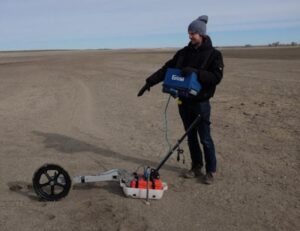Possibility of pre-Clovis camp in southern Alberta the “Holy Grail of archaeological research”
By Tim Kalinowski on April 24, 2021.
 Photo courtesy Gabriel Yanicke -
Projectile points and other tools discovered at Wally's Beach provide evidence that pre-Clovis peoples use of the site for hunting. Pictured: Researchers have used ground-pentrating radar to hunt for evidence of pre-Clovis human occupation.
Photo courtesy Gabriel Yanicke -
Projectile points and other tools discovered at Wally's Beach provide evidence that pre-Clovis peoples use of the site for hunting. Pictured: Researchers have used ground-pentrating radar to hunt for evidence of pre-Clovis human occupation.LETHBRIDGE HERALDtkalinowski@lethbridgeherald.com
Wally’s Beach just might turn out to hold the Holy Grail of archaeological research in North America, Gabriel Yanicke, curator of Western Archaeology at the Canadian Museum of History, recently told members of the Southeastern Archaeological Society: namely, a pre-Clovis human occupation site.
“The paradigm for a lot of years, the latter half of the 20th century really, was Clovis first,” stated Yanicke, who explained this supposition further in an interview with The Herald earlier this week. “Clovis is an archaeologically known culture defined primarily by a very distinctive style of stone projectile points– a fluted, lancellated spearpoint. That fluting is really distinctive, and it is the first style of stone tool to really show up all across North America, and it shows up all at once with a period of 150 to 300 years. So the Clovis culture appears, and then it disappears. It is replaced by later variants. But the dates on the bones at Wally’s Beach, and this is what makes the site so significant, pre-date the Clovis culture by as much as 300 years.”
So far, the only direct evidence of pre-Clovis people discovered by previous archaeological expeditions to Wally’s Beach is a few stone tools and projectile points left behind, and some distinctive butchering marks on prehistoric animal bones of the same era also found at Wally’s Beach, including prehistoric versions of now extinct camel, horses and bison of that late Pleistocene era. Tellingly, the tools and projectile points discovered are not fluted, and the carbon dating on the butchered bones prove that they date back over 13,300 years ago at the end of the last Ice Age just as what is known as the Southern Ice-Free Corridor was opening up for the first time.
“Wally’s Beach is both a paleontological and archaeological locality,” confirmed Yanicke. “The bones are there, and some of the species show evidence of human hunting. These are cut marks on bone, and the stone tools left by ancestral Indigenous people– some the first people to arrive in the newly deglaciated corridor.
So yeah, there is a human story there, and it is a very important one. Because when we are talking about the ice-free corridor we are potentially talking about some of the first moments of the first peopling of the New World, and the Indigenous peoples of North and South America.”
And while Yanicke believes there is a strong chance researchers will eventually discover a full pre-Clovis occupation site at Wally’s Beach, the challenge is where do you start digging for it?
The St. Mary River reservoir is enormous and only occasionally do water levels drop low enough to make archaeological research possible– usually as the wind strips away enough sediment to reveal preserved tracks of prehistoric animals and bones from that era.
Yanicke and his assistant, PhD student William Wadsworth, have been using ground-penetrating radar, drone driven aerial topography studies, and a close examination of the layering of soils in the region to build up a virtual computer map of the site to identify potential locations of undisturbed archaeology.
They also have to account for what is known as “deep time” in their computer modelling. In other words, they have to try to recreate what the geography and topography of the landscape looked like over 13,000 years ago to identify places where it might have been ideal to set up a more permanent human encampment site which nomadic pre-Clovis hunters might have returned to year after year for generations.
This is not an easy task, admitted Yanicke, as the St. Mary River has cut down over 35 metres deeper now from what used to be the level of its embankments at that time.
“The site was around at the end of the last Ice Age as the icing was melting,” explained Yanicke. “This area is what is referred to as the ice-free funnel of the southern corridor. It was opening up early, getting vegetated early, and these large game species were inhabiting this newly deglaciated territory. And Wally’s Beach was a shallow river crossing on the paleo St. Mary River; this was before the St. Mary carved the deep canyon that is today in the St. Mary.”
Yanicke is hopeful that he and his team will perhaps be able to return to Wally’s Beach as early as this fall to excavate a few of the preliminary sites they have discovered which he knows have undisturbed layers dating to that time.
“The Holy Grail of archaeological research in Alberta for a long time was identifying a Clovis site,” he stated. “Wally’s Beach shifted that narrative to pre-Clovis. That’s the target focus of this: to really focus on a late Pleistocene human occupation site, and hopefully encounter significant cultural occupation on a large scale.”
Follow @TimKalHerald on Twitter
Follow @@TimKalHerald on Twitter
4-3




